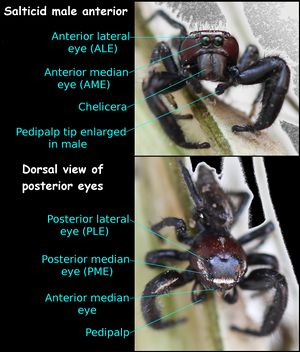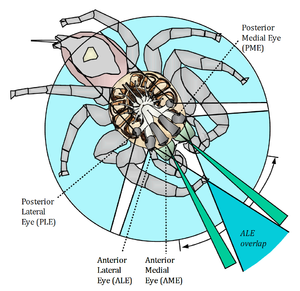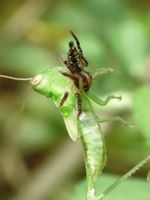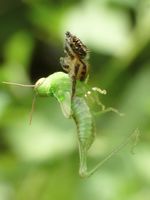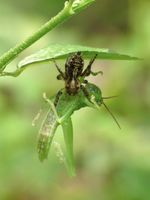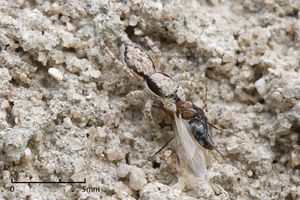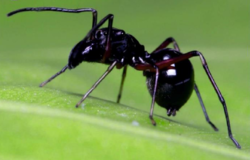العنكبوت القافز
| العناكب القافزة Jumping spiders | |
|---|---|
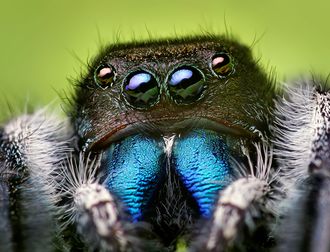
| |
| ذاكر بالغ Phidippus audax | |
| التصنيف العلمي | |
| أصنوفة غير معروفة (أصلحها): | الحياة |
| مملكة: | الحيوانية |
| Phylum: | مفصليات الأرجل |
| الشعيبة: | كلابيات القرون |
| فوق رتبة: | رتيلاوات الشكل |
| الفصيلة: | العنكبوت القافز بلاكوال، 1841 |
| أجناس | |
| Diversity | |
| 600+ جنس، 5000+ نوع | |

| |
العناكب القافزة، هي مجموعة من العناكب ضمن فصيلة تحمل نفس الاسم. تحتوي هذه الفصيلة على ما يقارب 635 جنس موصف وحوالي 6080 نوع،[1] مما يجعلها أكبر عائلة عناكب بما يقارب 13% من جميع الأنواع.[2] تتمتع العناكب القافزة بأفضل رؤية بين مفصليات الأرجل وتستخدم هذه الميزة في المغازلة، الصيد والتنقل. على الرغم من أنها تتحرك عادة بشكل غير ملحوظ وبطيء إلى حد ما، فإن معظم الأنواع قادرة على القفز السريع، خاصة عند الصيد، لكن يحدث ذلك في بعض الأحيان كاستجابة للتهديدات المفاجئة أو لعبور الفجوات الطويلة. وقد شهد رئتيها الكتابية والقصبات الهوائية لديها تطوراً كبيراً، وتستخدمها العناكب القافزة معاً (تنفس ثنائي). تُعرف العناكب القافزة بصفة عامة من نمط أعينها. تمتلك العناكب القافزة جميعاً أربع أزواج من الأعين، وزوج أمامي كبير في الوسط.
السمات المميزة
العناكب القاقزة هي بين أسهل العناكب تمييزاً عن باقي فصائل العناكب المشابهة بسبب شكل cephalothorax وأنماط عيونهم. The families closest to Salticidae in general appearance are the Corinnidae (distinguished also by prominent spines on the back four legs), the Oxyopidae (the lynx spiders, distinguished by very prominent spines on all legs), and the Thomisidae (the crab spiders, distinguished by their front four legs, which are very long and powerful). None of these families however, has eyes that resemble those of the Salticidae. Conversely, the legs of jumping spiders are not covered with any very prominent spines. Their front four legs generally are larger than the hind four, but not as dramatically so as those of the crab spiders, nor are they held in the outstretched-arms attitude characteristic of the Thomisidae.[3] In spite of the length of their front legs, Salticidae depend on their rear legs for jumping. The generally larger front legs are used partly to assist in grasping prey,[4] and in some species, the front legs and pedipalps are used in species-recognition signalling.
The jumping spiders, unlike the other families, have faces that are roughly rectangular surfaces perpendicular to their direction of motion. In effect this means that their forward-looking, anterior eyes are on "flat faces", as shown in the photographs. Their eye pattern is the clearest single identifying characteristic. They have eight eyes, as illustrated.[3][4] Most diagnostic are the front row of four eyes, in which the anterior median pair are more dramatically prominent than any other spider eyes apart from the posterior median eyes of the Deinopidae. There is, however, a radical functional difference between the major (AME) eyes of Salticidae and the major (PME) eyes of the Deinopidae; the large posterior eyes of Deinopidae are adapted mainly to vision in dim light, whereas the large anterior eyes of Salticidae are adapted to detailed, three-dimensional vision for purposes of estimating the range, direction, and nature of potential prey, permitting the spider to direct its attacking leaps with great precision. The anterior lateral eyes, though large, are smaller than the AME and provide a wider forward field of vision.
الصف الخلفي من العيون الأربع يمكن وصفه بأنه strongly bent, or as being rearranged into two rows, with two large posterior lateral eyes furthest back. They serve for lateral vision. The posterior median eyes also have been shifted out laterally, almost as far as the posterior lateral eyes. They are usually much smaller than the posterior lateral eyes and there is doubt about whether they are at all functional في أنواع عدة.
طول جسم العنكبوت القافز يتراوح عموماً بين 1 إلى 25 مم.[3][5] أكبرهم هو Hyllus giganteus,[5] بينما الأجناس الأخرى ذات الأنواع الأكبر نسبياً بما في ذلك Phidippus, Philaeus و Plexippus.[6]
بالإضافة إلى استخدام حريرهم كحبال سلامة أثناء القفز، فإنهم يبنون أيضاً silken "pup tents"، حيث يختبئون من الطقس السيء وينامون ليلاً. They molt within these shelters, build and store egg cases within them, and also spend the winter in them.[7]
الموئل
تعيش العناكب القافزة في مختلف الموائل. تضم الغابات المدارية معظم الأنواع، ولكنهم يتواجدون أيضاً في الغابات المعتدلة، والفيافي، والصحاري، نطاقات المد، والمناطق الجبلية. العناكب الواقفة على كل شيء هي النوع الذي جـُمـِع في أعلى ارتفاعات، على سفوح جبل إڤرست.[8]
الرؤية
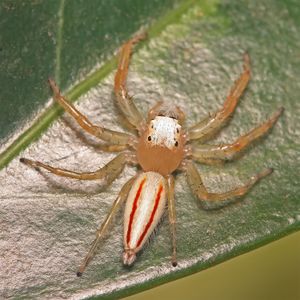
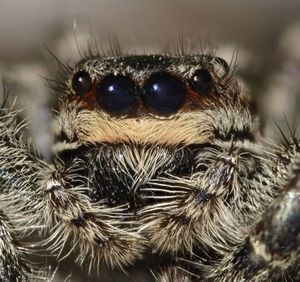
السلوك
الصيد
النظام الغذائي
التكاثر
السلوك العام للتزاوج
Jumping spiders conduct complex, visual courtship displays using both movements and physical bodily attributes. Unlike females, males possess plumose hairs, colored or iridescent hairs (particularly pronounced in the peacock spiders), front leg fringes, structures on other legs, and other, often bizarre, modifications. These characteristics are used in a courtship "dance" in which the colored or iridescent parts of the body are displayed. In addition to the display of hairs, jumping spiders perform complex sideling, vibrational, or zigzag movements to attract females. If receptive to the male, the female will assume a passive, crouching position. It has also recently been discovered that many males have auditory signals as well. These amplified sounds presented to the females resemble buzzes or drum rolls.[9] In some species, the female may also vibrate her palps or abdomen. The male will then extend his front legs towards the female to touch her. If the female remains receptive, the male will climb on the female's back and inseminate her with his palps.[10]
استعراضات الغزل البصرية والغير بصرية
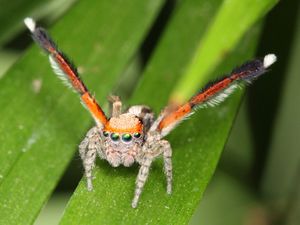
تبعات المثنوية الشكلية الجنسية
رعاية الصغار
في ديسمبر 2018، نشرت مجلة ساينس توصل باحثون صينيون إلى أن إناث العنكبوت "العنكبوت المحاكي للنمل الأسود Toxeus maguns"، أحد أنواع العنكبوت القافز، تفرز سائلاً يشبه الحليب لإطعام صغارها. ووجدت الدراسة أن العناكب الأمهات تواصل توفير هذا السائل، الذي يحتوي على نحو أربع أضعاف كمية الپروتين الموجودة في حليب الأبقار، لفترة طويلة بعد أن يصبح صغارها بالغين. [11]
ورغم أن العناكب لا تستخدم الغدد الثديية لإنتاج السائل، وبالتالي فهذه لا تعتبر عملية رضاعة بالمعنى المعروف، إلا أن النتائج قد تدفع العلماء لإعادة النظر فيما يعرفونه عن الرضاعة وكيفية تطورها، وفقاً للباحثين.
واعتبر علماء الأحياء في الأكاديمية الصينية للعلوم أن اكتشاف مثل هذا السلوك الشبيه بالثدييات في العنكبوت أو أي من اللافقاريات كان مفاجأة.
وهذا النوع من العناكب، "العنكبوت القافز المحاكي للنمل الأسود"، يشبه النمل، ويمشي مثلها كما أنه يحرك ساقيه الأماميتين في الهواء مثل زوج الهوائيات في النمل، لكنه يقفز عندما يتعرض للتهديد أو يصطاد. وهذه الأنواع يوجد معظمها في جنوب شرق آسيا.
التصنيف
| التصنيف ضمن العناكب (Araneae)[12] | |||||||||||||||||||||||||||||||||||||||||||||||||||||||||
|
|
أنماط المحاكاة
الأحفورات
انظر أيضاً
المصادر
- ^ Maddison, Wayne P. (November 2015). "A phylogenetic classification of jumping spiders (Araneae: Salticidae)". Journal of Arachnology. 43 (3): 231–292. doi:10.1636/arac-43-03-231-292.
- ^ Peng, Xian-Jin; Tso, I-Min; Li, Shu-Qiang (2002). "Five New and Four Newly Recorded Species of Jumping Spiders from Taiwan (Araneae: Salticidae)" (PDF). Zoological Studies. 41 (1): 1–12. Retrieved 28 January 2016.
{{cite journal}}: Unknown parameter|lastauthoramp=ignored (|name-list-style=suggested) (help) - ^ أ ب ت Richman, D.B.; Edwards, G.B.; Cutler, B. (2005). "Salticidae". In Ubick, D.; Paquin, P.; Cushing, P.E.; Roth, V. (eds.). Spiders of North America: an identification manual. American Arachnological Society. pp. 205–216. ISBN 978-0-9771439-0-0.
{{cite book}}: Unknown parameter|lastauthoramp=ignored (|name-list-style=suggested) (help) - ^ أ ب Crompton, J. (1954). The Life of the Spider. New York: New American Library (reprint). p. 77. OCLC 2896911.
- ^ أ ب "Watch the world's biggest jumping spider make a leap". BBC Earth. 2016-01-29. Retrieved 2016-06-18.
- ^ Macík, Stanislav (2012-08-27). "Phiddipus regius: the Jewel between Spider Predators". arachnos.eu. Retrieved 2016-06-18.
- ^ Foelix, Rainer F. (1996). Biology of Spiders. Oxford University Press. p. 11. ISBN 978-0-674-07431-6.
- ^ Wanless, F. R. (1975). "Spiders of the family Salticidae from the upper slopes of Everest and Makalu". Bulletin of the British Arachnological Society. 3 (5): 132–136.
- ^ Elias, DO; Mason, AC; Maddison, WP; Hoy, RR (2003). "Seismic signals in a courting male jumping spider". The Journal of Experimental Biology. 206 (22): 4029–4039. doi:10.1242/jeb.00634. PMID 14555743.
- ^ Foelix, Rainer F. (1996). Biology of Spiders. Oxford University Press. pp. 195–197. ISBN 978-0-674-07431-6.
- ^ "Jumping Spider Suckles Spiderlings Like They're a Litter of Kittens". مجلة ديسكڤر. 2018-12-10. Retrieved 2018-12-10.
- ^ Wheeler, Ward C.; Coddington, Jonathan A.; Crowley, Louise M.; et al. (December 2016). "The spider tree of life: phylogeny of Araneae based on target-gene analyses from an extensive taxon sampling". Cladistics. 33 (6): 574–616. doi:10.1111/cla.12182.
خطأ استشهاد: الوسم <ref> ذو الاسم "HarlJack00" المُعرّف في <references> غير مستخدم في النص السابق.
<ref> ذو الاسم "PeasWils89" المُعرّف في <references> غير مستخدم في النص السابق.قرءات إضافية
- Vasilevsky, M. (2012). A Classical Taxonomic Guide to Identifying Fifty Unique North American Jumping Spiders. Lulu.قالب:Self-published-inline
- Kaston, B.J. (1953). How to Know the Spiders. Pictured key nature series (1st ed.). Dubuque, IA: W.C. Brown Co. OCLC 681432632.
- Forster, L.M. (1982). "Vision and prey-catching strategies in jumping spiders". American Scientist. 70: 165–175.
- Jackson, R.R. (1982). "The behavior of communicating in jumping spiders (Salticidae)". In Witt, P.; Rovner, J. (eds.). Spider Communication Mechanisms and Ecological Significance. Princeton, NJ: Princeton University Press. pp. 213–247. OCLC 951407473.
- Jackman, John A. (1997). A Field Guide to Spiders & Scorpions of Texas. Houston, TX: Gulf Publishing Company. p. 127.
- Nakamura, T.; Yamashita, S. (2000). "Learning and discrimination of colored papers in jumping spiders (Araneae, Salticidae)". Journal of Comparative Physiology A. 186 (9): 897–901. doi:10.1007/s003590000143.
- Elias, D.O.; Mason, A.C.; Maddison, W.P.; Hoy, R.R. (2003). "Seismic signals in a courting male jumping spider (Araneae: Salticidae)". Journal of Experimental Biology. 206 (22): 4029–4039. doi:10.1242/jeb.00634. PMID 14555743.
- Lim, M.L.M.; Li, D. (2005). "Extreme ultraviolet sexual dimorphism in jumping spiders (Araneae: Salticidae)". Biological Journal of the Linnean Society. 89 (3): 397–406. doi:10.1111/j.1095-8312.2006.00704.x.
وصلات خارجية
- Asian jumping spiders and photo references
- Comprehensive resource on the morphology and taxonomy of jumping spiders (Salticidae): www.jumping-spiders.com
- Global Species Database of Salticidae
- Video of a jumping spider's mating behavior
- World Spider Catalog
- Jumping Spiders of NW-Europe
- Jumping spiders of Australia
- American Jumping Spiders – 70 Species Videos (includes introduction to salticids, predation, mating, and other behaviors)
- Movies of Habronattus courtship behavior
- Male jumping spider courtship dance with contact microphone picking up and amplifying sounds
- The Australian Faunal Directory taxonomic classification of Australian salticids
